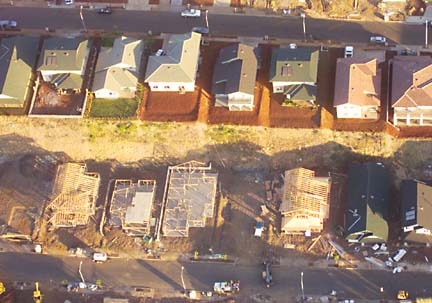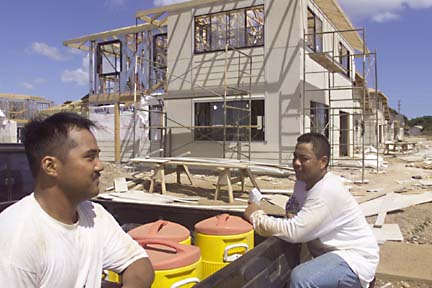
The Ewa Plain, once covered with fields of waving sugar cane, has been transformed into Oahu's newest target for urban development, centered on Kapolei as a "second city." That designation reflects hopes that Kapolei will avoid being another bedroom community by luring businesses to employ residents, reducing traffic on highways packed with commuters.
Kapolei's lower real estate prices are seen in cost-saving designs that have several houses sharing common driveways and offer minimal yards, although a few more upscale units peek from behind fences that characterize the community.
A few miles east, Waikele -- initially known for its discount outlet stores -- also offers more affordable homes, especially for first-time buyers who want to stay in the Waipahu area. Twelve years old, it has reached capacity with about 6,000 residents who favor its proximity to freeways that can take them to the north and toward urban Honolulu -- as fast as traffic will allow.
Waikele | Kapolei
BACK TO TOP |
DENNIS ODA / DODA@STARBULLETIN.COM
There is a lot more than shopping going on at Waikele Outlet stores. Four-year-old Kaori Murakawa, left, Leina Mizusawa, 5, and her sister Lauren, 2, play on one of the many children's playthings at the center.
Area offers more
than discount shopsResidents like having upgraded schools,
a golf course and large parks close to home
With lollipop-shaped banyan trees lining Kamehameha Highway and palm trees standing tall at the entrance of a community overlooking Pearl Harbor, Waikele has welcomed residents and visitors alike to shop at its outlet stores, practice soccer in its parks or swing golf clubs on the green.
"It's a small, safe, green, clean community," said resident Kiana Moore.
Located between the H-1 and H-2 freeways, Waikele has revitalized the old plantation town of Waipahu with new affordable and single-family homes, the state's first outlet center, a new elementary school and an 18-hole golf course.
An estimated 6,000 residents make up the 12-year-old Waikele community that saw completion of its last subdivision, Celebrations at Waikele, last fall. Some Waikele residents commended developers for constructing a well-planned community.
In early years, Oahu Sugar Co. cultivated sugar cane on the land. In 1982, the land was allowed to go fallow, and ratoon sugar cane was planted to prevent erosion and control dust.
Chris Kanazawa, then senior vice president of Amfac/JMB Hawaii Inc., said a master plan community was designed for the 577-acre site.
"We wanted to create a community that not only provided affordable housing for first-time buyers, but also an opportunity for those who lived in Waipahu or Waipio-Gentry to upgrade their housing," said Kanazawa. Homeowners began moving into the community in 1991.
DENNIS ODA / DODA@STARBULLETIN.COM
Brenda Nisperos, from left, Virginia Balansag, Flor Lacamenpo and her sister, Lucena Lacamenpo, spent an afternoon shopping at the Waikele Outlet stores.
"Everything is accessible. The shopping center is right there. The school is close. I don't have to leave the community to get what I need," said Moore, who lives at Fairway Village with her husband, Randy, and two children.
Residents statewide and visitors primarily from Japan frequent Waikele Premium Outlets, which has stores such as Banana Republic, Kenneth Cole and Saks Fifth Avenue Outlet-Off 5th.
The Waikele Golf Course was created by renowned golf course architect Ted Robinson and attracts an estimated 80,000 golfers a year. Parties and meetings are held at a clubhouse that was designed in a modern plantation style to reflect the town's history.
Five years ago, Waikele Elementary School was built with air-conditioned rooms. It has an enrollment of 800 K-6 students. It was important to complete the community with a school, Kanazawa said.
"It's a wonderful place to live and raise a family," said Craig Richter, a member of the Waipahu Neighborhood Board who lives at Fairway Village with his wife, Terry, and three children.
Mitsuo Shito, former state House representative for the Waipahu district and former executive director of the state Hawaii Housing Authority, purchased a home at Golf Club Estates when it was built.
"I think it blends and complements Waipahu," said Shito, president of the Waikele Community Association. "There is a lot of aloha that exists in the community."
BACK TO TOP |
RICHARD WALKER / RWALKER@STARBULLETIN.COM
Kapolei is Oahu's fastest-growing region, with numerous homes and offices going up, including the homes at Kapolei Knolls.
Construction constant
in growing region
During the past decade and a half, no community on Oahu has changed more than Kapolei.
That's because 15 years ago Kapolei -- at least the area known as the city of Kapolei --didn't exist. It was home to old sugar cane fields and little else.
Today, Kapolei is a bustling community with several thousand homes, a busy business district and a Leeward hub for government offices.
It is the center of Oahu's fastest-growing region, thanks in part to government decisions dating to the 1970s to steer public and private development to Kapolei to create a so-called second city for Oahu.
The idea behind the policy: Create a community where people could live, work and play to help ease the commuter traffic into Honolulu and reduce urban sprawl.
Public and private developers, including Campbell Estate, the city's landowner and overall developer, have spent well more than $1 billion (not including residential projects) since 1990 to transform the former cane lands into a thriving community.
Among the projects that have been built: a shopping center and elementary, middle and high schools. Kapolei also has a newly built police station for the region, plus office buildings for the state and county governments.
FL MORRIS / FMORRIS@STARBULLETIN.COM
Apprentice carpenters Chad Castillo, left, and Jaylord Batugo talk at the end of the workday at a Kapolei construction site.
Last year alone, more than $475 million in construction projects (excluding residential) were started in Kapolei.
Construction still is a constant in the region. Developers are building new homes to house the steady stream of new residents moving to the area. Work is under way, for instance, on a 204-home project in the Villages of Kapolei, which has about 2,700 homes.
Businesses also are taking part in the building boom, attracted by the population growth and relatively high median household incomes.
Along with the rapid growth, however, have come the attendant problems, such as bad rush-hour traffic and crowded schools.
Despite such growing pains, Janice Lehner, who with her family was among the first residents of the Villages of Kapolei, the government-planned master community that welcomed its first homeowners in 1990, likes what has sprung up around her. "This is home," said Lehner, mother of a 16-year-old and 22-year-old. "It's still a comfortable place to live. I wouldn't change it."
John Riggins, a real estate agent who moved to Kapolei in 1993, echoed her comments.
"I'm real happy with the area," he said. "It's a fabulous place to live. Overall, I think this is the future for the island of Oahu."
The greater Kapolei region includes Makakilo, Campbell Industrial Park and the Ko Olina resort area, another focal point of growth.







